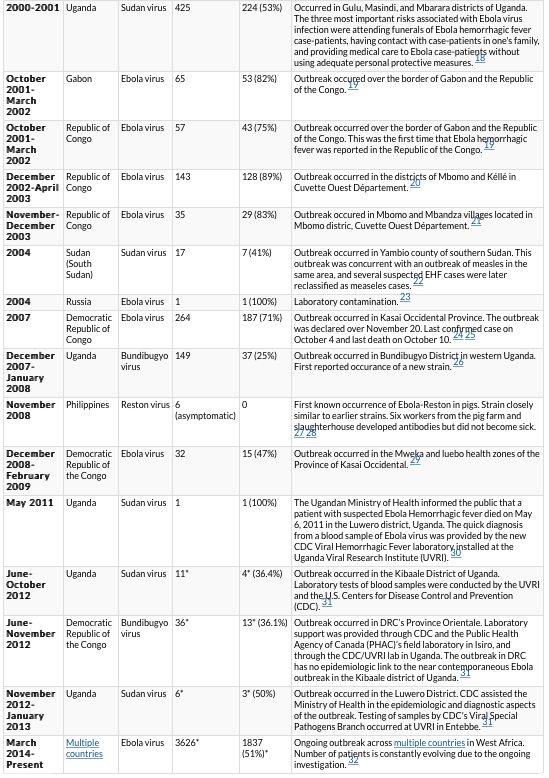This article was last updated on April 16, 2022
Canada: ![]() Oye! Times readers Get FREE $30 to spend on Amazon, Walmart…
Oye! Times readers Get FREE $30 to spend on Amazon, Walmart…
USA: ![]() Oye! Times readers Get FREE $30 to spend on Amazon, Walmart…An interesting 2012 study by scientists at the Canadian Food Inspection Agency (CFIA) entitled "Transmission of Ebola Virus from pigs to non-human primates" takes an interesting look at how the Zaire variant of the Ebola virus can be transmitted between pigs and from pigs to macaques without direct contact.
Oye! Times readers Get FREE $30 to spend on Amazon, Walmart…An interesting 2012 study by scientists at the Canadian Food Inspection Agency (CFIA) entitled "Transmission of Ebola Virus from pigs to non-human primates" takes an interesting look at how the Zaire variant of the Ebola virus can be transmitted between pigs and from pigs to macaques without direct contact.
One of the Ebola viruses that has already made it to North America, the Reston variant/subspecies, does not seem to be a cause of the disease in humans and was the cause of the outbreak of Ebola in Reston, Virginia in 1989 and discussed in this posting. The Reston subspecies appears to have resulted from a mutation of the Ebola virus and this particular virus causes hemorrhagic fever in monkeys and can be transmitted to humans who remain asymptomatic. The same cannot be said for the Zaire subspecies (aka Ebola) which is quite lethal as you can see on this chart from the Centers for Disease Control:
Coincidentally, it also happens that the current Ebola outbreak has been caused by the Zaire subspecies.
In the study by CFIA researchers, scientists inoculated six week old piglets with the Zaire Ebola Kikwit 95 (ZEBOV) oro-nasally. The piglets were then transferred to pig pens in the same room where four cynomolgus macaques were housed in two levels of individual cages, separated from the piglets by a wire barrier 20 centimetres (8 inches) in front of the bottom level of cages to prevent direct contact between the two species.
All of the piglets developed symptoms of Ebola between five and seven days following the inoculation and recovered within nine days after infection. Autopsies showed that all piglets had developed antigens showing the presence of the virus in their systems.
All four of the macaques were healthy until seven days after exposure, however at eight days after exposure, two of the macaques developed petechial hemorrhages on their skin and along internal surfaces of their arms and legs and were euthanized. The other two macaques remained healthy until twelve days after exposure when they showed clinical signs of Ebola infection. When they were euthanized, examination of their internal organs showed that there was damage to the lungs and liver. Both lungs show a pattern of lesions that suggested infection of the lungs due to the spread of the virus. It is also important to note that it appears that the piglets were able to remain symptom-free at the same time as they transmitted the disease to the macaques.
The study concludes:
"The present study provides evidence that infected pigs can efficiently transmit ZEBOV to NHPs in conditions resembling farm setting. Our findings support the hypothesis that airborne transmission may contribute to ZEBOV spread, specifically from pigs to primates, and may need to be considered in assessing transmission from animals to humans in general. The present experimental findings would explain REBOV (Reston Ebola Virus) seropositivity of pig farmers in Philippines that were not involved in slaughtering or had no known contact with contaminated pig tissues. The results of this study also raise a possibility that wild or domestic pigs may be a natural (non-reservoir) host for EBOV participating in the EBOV transmission to other species in sub-Saharan Africa." (my bold)
You'll note that the study concluded that airborne transmission may contribute to the spread of ZEBOV (Zaire Ebola virus). Why is it then that the CDC says this:
“When an infection does occur in humans, the virus can be spread in several ways to others. Ebola is spread through direct contact (through broken skin or mucous membranes) with
• blood or body fluids (including but not limited to urine, saliva, feces, vomit, and semen) of a person who is sick with Ebola
• objects (like needles and syringes) that have been contaminated with the virus
• infected animals
• Ebola is not spread through the air or by water, or in general, food. However, in Africa, Ebola may be spread as a result of handling bushmeat (wild animals hunted for food) and contact with infected bats.” (my bold)
For my Canadian readers, this is what the Public Health Agency of Canada has to say about the spread of Ebola:
The Ebola virus can spread through:
▪ contact with infected animals
▪ contact with blood, body fluids or tissues of infected persons
▪ contact with medical equipment, such as needles, contaminated with infected body fluids
Exposure can occur in health care settings when staff do not wear appropriate protective equipment, such as masks, gowns and gloves.
As long as precautions are taken, there is low risk of contracting EVD in a country where the disease is present.”
It certainly would appear that at least some governments are ignoring science in their efforts to calm the masses, doesn’t it? While we should be cautious when extrapolating these results to human-to-human transmission of Ebola and while I don't want to appear to be one of the tin foil hat crowd, as a scientist, the CFIA study certainly should give us reason to be cautious about what we are being told. Considering that I found this study quite easily on the internet, I wonder why governments are choosing to ignore its conclusions?
Click HERE to read more of Glen Asher's columns
You can publish this article on your website as long as you provide a link back to this page.



Be the first to comment